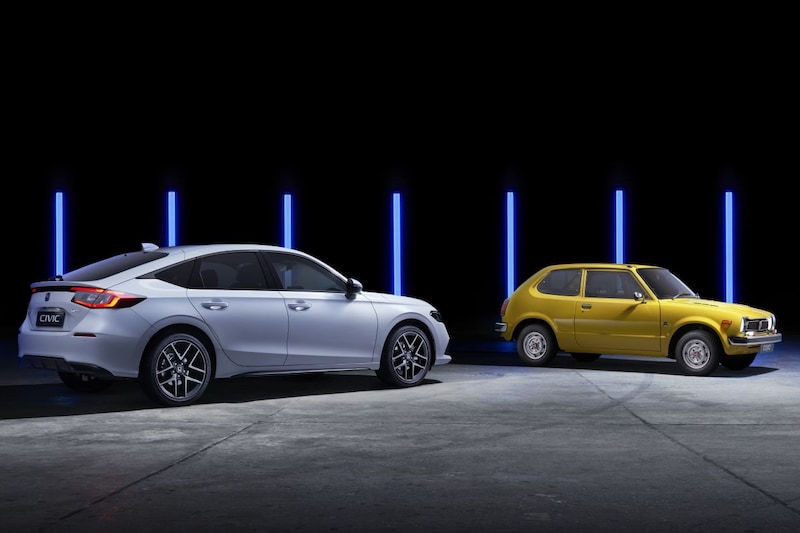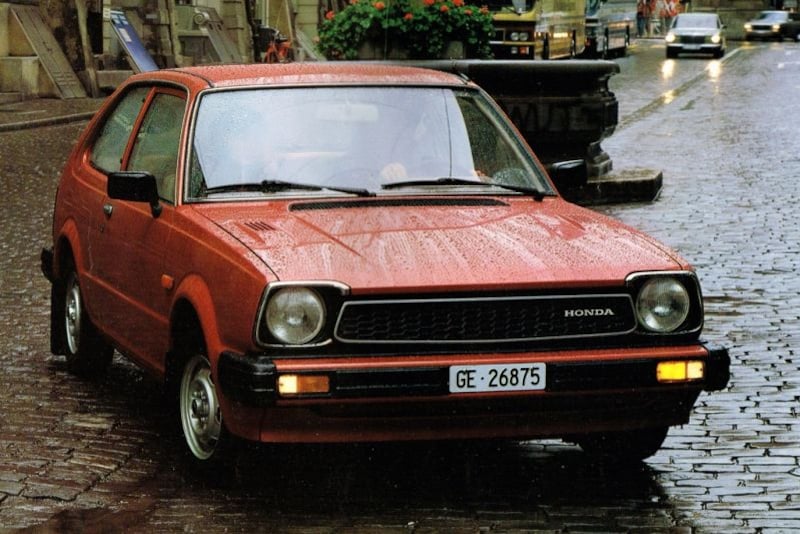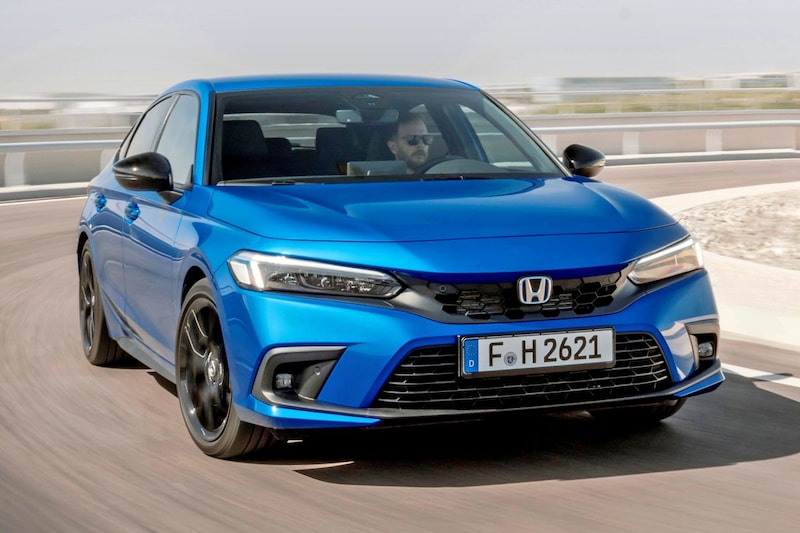Quite a laundry list


The garlands may appear at Honda, because the Japanese celebrate the 50th anniversary of the Civic. Since 1972, Honda has sold more than 27.5 million copies of the birthday girl worldwide. A great moment to take a tour of all generations of Civic.
First generation (1972-1979)

First generation Honda Civic
Just before the outbreak of the oil crisis in 1973, Honda introduced the first generation Civic. Honda entered the global market for the first time in its history with the Civic. The timing could not have been better, because precisely then there was a great need for fuel-efficient cars due to the oil crisis. That economy was partly achieved by Honda’s CVCC technology. This abbreviation stands for ‘Compound Vortex Controlled Combustion’ and, in a nutshell, contributes to more efficient combustion. In the first four years of the Civic’s existence, Honda already produced one million units. The first Civic was available as a two- and four-door sedan, three- and five-door hatchback, and as a five-door station wagon. In terms of silhouette, there was hardly any difference between the sedan and the hatchback. The difference is in the rear window, which is fixed on the sedan and hinges on the hatchback when the tailgate is opened.
Second generation (1979-1983)

The second generation was slightly larger and more angular
After seven years, Honda thought it was time for a new generation Civic. Its design is not very different from the first Civic, but the car was larger, had a more angular bumper and a different grille, headlights and taillights. With the second generation Civic, Honda did add a ‘real’ sedan with a longer butt to the range. The Civic’s engines were given more power and Honda had further refined the CVCC system. A special version of the second generation Civic is the Civic Country (photo 4), a station wagon with wooden panels on the sides and the boot lid. This reminds him of the American ‘woodies’ of yesteryear. A long life was not granted to the second generation Civic. After only four years, Honda thought it was time to retire him.
Third generation (1983-1987)

Much more angular than before
Where the second generation Civic was more of an evolution compared to its predecessor, the third generation Civic can safely be called a revolution. The appearance of the Civic became a lot more angular and it immediately looked much more modern than its predecessors. The Civic also got a wider track and Honda added a number of special variants to the range. The five-door hatchback and the station wagon were merged into the ‘Civic Shuttle’ (photo 7), a hatchback with a kind of bay window on the back. The Japanese also introduced the Civic CRX (photo 6), which clearly had to appeal to a sportier audience. Later Honda introduced the CRX as a separate model.
Fourth generation (1987-1991)

An improvement especially under the skin
Both the third and fourth generations of the Civic only lasted four years. Compared to the third generation, the fourth generation Civic is not a radical innovation, but it does bring an important novelty under the skin: the now well-known VTEC system. For that you had to dig deep into your pocket, because the 1.6i VTEC with a power of 150 hp was immediately the top motorization. With that power source, the 1,030 kilogram Civic was able to hit 100 km/h in 7.3 seconds and continue to chase up to a top speed of 208 km/h. Even today, those are still good numbers. However, the VTEC was almost twice as expensive as the basic version, the 1.3 Luxe. Converted to euros, the latter was on the price list for €11,158. For the VTEC you had to bring a whopping €21,164 to the Honda dealer.
Fifth generation (1991-1995)

Some more rounded lines for the fifth generation
Honda moved away from the angular shapes with the fifth generation of the Civic and the brand went a bit more with the rounder lines that characterized cars from the 90s. That was not without reason, because Honda wanted to make the Civic more aerodynamic in order to further reduce fuel consumption. The station wagon was only on the price list in Japan, in the other continents it disappeared from the range. There was another, less practical variant in return: the Civic Coupé (photo 10). From this generation, the Civic became quite popular with the tuning guild, so finding a completely original copy is almost impossible nowadays.
Sixth generation (1995-2000)

The first Honda Civic Type-R
With the sixth generation Civic, not only did the design of the headlights and taillights change, but the silhouette of the car was also overhauled. The rear of the hatchback was a lot more oblique than before. Honda also introduced the Civic Type R for the first time: a hot version with a 185 hp 1.6 VTEC under the hood. Unfortunately, that upper-Civic was reserved for the Japanese market. However, the sixth generation Civic marked the return of the station wagon: the ‘Aero Deck’.
Seventh generation (2000-2005)

Honda Civic
The Type-R finally came to our country with the seventh generation Civic. Honda also brought back the five-door hatchback, but the station wagon was dropped again. More important, however, is the arrival of the first hybrid Civic (photo 13). This Civic IMA was only on the Dutch price list for a year, but was a harbinger of the success that Honda would later book with the hybrid Civic.
Eighth generation (2005-2011)

A radical turnaround
That success came with the eighth-generation hybrid Civic, which was only listed as a sedan. That was also the only available variant of the Civic Sedan with us. The eighth-generation hatchback was quite different in appearance from that sedan. At the front, the Civic had optically connected headlights and taillights and a split rear window. Those design elements made the car look quite futuristic. The eighth generation Civic also had the ‘Magic Seats’ for the first time, where the seat of the rear seat can be folded up for extra storage space. In 2008 Honda came with a facelift for the eighth generation, which also included the sporty Type S and -R on the price list.
Ninth generation (2011-2017)

A clear further development of its predecessor
The ninth generation Civic clearly continued in appearance from its predecessor, but the headlights were no longer optically connected. The rear lights do, but via the ‘rear spoiler’ that divided the rear window in two. The Civic Hybrid disappeared from the price list, just like the three-door, but the Civic Tourer made its appearance. This station wagon had a striking design, especially at the rear. It was only in 2015, with the facelift, that Honda delivered the Civic Type R again in the Netherlands.
Tenth generation (2015-2021)

The tenth generation overlapped with the ninth generation worldwide.
In 2015, the North American market was already introduced to the tenth generation of the Honda Civic. That would take a while with us, because until 2017 the ninth generation remained on the price list. With the tenth generation Civic, Honda continued to use the design language with sharp lines, but threw the body styles on the shovel. The Civic was available as a hatchback and sedan, with the latter being 13 centimeters longer. The Civic Sedan was considerably less popular here and only available with 1.5 i-VTEC. You could also get the hatchback with 1.0 i-VTEC and as a mighty 320 hp Type-R. The tenth generation Civic was not successful in our market. In fact, sales had been in the doldrums since 2010, but from 2018 – when Honda managed to sell 356 Civics in the Netherlands – it only went further downhill. Quite a contrast to the record year of 1988, when Honda still sold 8,484 copies of the Civic.
Eleventh generation (2021–present)

Eleventh generation Civic: as a hybrid again.
Despite the plummeting sales figures, Honda also brings the eleventh generation Civic to the Netherlands. For the time being, however, it only comes to us as a hybrid hatchback, while it is also available as a sedan elsewhere in the world. A new Civic Type-R is also in the pipeline, but it is still a bit unclear for that top model what Honda will do with the powertrain and whether the Type-R will also receive some form of electrification. Enthusiasts don’t have to worry anyway, because the Civic Type-R is going to make the crossing to Europe anyway!
.
– Thanks for information from Autoweek.nl




